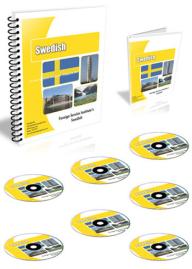Foreign Service Institute's Swedish Basic Course Printed Text Book and Audio CDs
Publisher: Ultimate Language Store 2008 | ISBN n/a | Language English | Audio CD in MP3 | 210 MB
Publisher: Ultimate Language Store 2008 | ISBN n/a | Language English | Audio CD in MP3 | 210 MB
The Foreign Service Institute has developed a series of language-learning courses for use by the state department and other government agencies. These courses have been developed, tested by use, and improved over a period of many years. Working with the Departments of Defense, Education, other government agencies, and various universities, the Foreign Service Institute has created the largest body of complete courses for languages of the world available anywhere.
This course produced by the Foreign Service Institute as part of its Basic Course series, provides introductory through intermediate level material. The goal of Foreign Service Institute courses is to provide the English Speaking student's from any occupational background with practical knowledge and proficiency in their language of interest.
The Swedish Basic Course provides all of the essential information and vocabulary for learning to speak everyday Swedish. It uses drills and exercises to cover a wide range of conventional situations, and also covers grammatical structure and pronunciation pitfalls that present difficulties for the English speaker. The latter part of the course emphasizes reading and translation.
The FSI Swedish Basic Course developed from a need to provide a more comprehensive and up to date curriculum than had been afforded by an earlier work, Spoken Swedish. The latter had been produced during the 1950's by William R. Van Buskirk and Fritz Frauchiger of the FSI linguistic staff, with the assistance of members of the staff of the Post Language Program of the American Embassy in Stockholm. It was originally developed especially for the future U.S. diplomat in Sweden, and is meant to also provide a source of cultural information.
We all know that the ability to speak a foreign language and to live in a new culture is not learned through books and tapes alone. These are only aids in a learning process which begins in the classroom, where the instructor is the primary source of information and your main conversation partner, and which later expands to the whole country of Sweden, where a nation becomes your teacher. However, the book has taken into account the student who may not have a teacher available. It was designed in such a way that, together with extensive use of the course, it may be used profitably by the self-study student.
It is hoped that this course will serve as one of many aids in your endeavor and that you will find numerous opportunities to practice your Swedish. The best way of doing that is to close your book and put your vocabulary and grammar to use in real situations. This is when you have to transfer your course-learning into something productive and meaningful. When you speak, understand, and read outside the classroom environment you have truly learned to communicate in your new language.
The first twelve Units consist of dialogs which cover a range of situations relevant to your life and work in Sweden. The last few Units are laid out in a narrative form and constitute a transition to further comprehension.
Each Unit includes Notes on Basic Sentences, which clarify certain grammar points, cultural information and idiomatic expressions that are particularly important.
Following Notes on Basic Sentences is a section called Points to Practice. This section deals with the grammar, which is first explained as clearly and simply as possible, and then put to use in Practices. Here you can cover up the correct responses with a piece of heavy paper or cardboard and then slide the paper down the page to confirm the correctness of your response or correct any error you may have made. Be sure you do the Practices aloud.
Grammatical explanation should be thought of only as a tool when learning a foreign language. But it is the key to understanding a structure and a system which might otherwise seem confusing. Even though Swedish grammar and vocabulary are related to their English counterparts, a word-by-word translation from either language into the other does not necessarily produce good sense. Because of important differences in ways we have of expressing the same thoughts, speakers of English and Swedish see each other as using different patterns of language. It is therefore invaluable to learn Swedish patterns to the point where they become a real part of your speech, so that the difference between English and Swedish becomes natural to you.
Over many years of teaching Swedish to English speaking students the teachers at FSI have noted consistent patterns of difficulty that an English speaker has in learning Swedish. They have tried to draw on this experience in explaining the grammar and in pointing out the pitfalls. The happy Vikings are used to draw attention to some of the grammar points, and to make the task of learning Swedish grammar a little less serious. A dragon appears in places where we discuss something that may be unusually tricky.
Thanks to original uploader!







